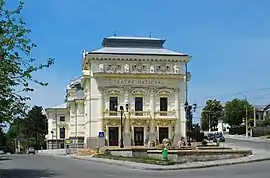Caracal, Romania
Caracal (Romanian pronunciation: [kaˈrakal] ⓘ) is a city in Olt County, Romania, situated in the historic region of Oltenia, on the plains between the lower reaches of the Jiu and Olt rivers. The region's plains are well known for their agricultural specialty in cultivating grains and over the centuries, Caracal has been the trading center for the region's agricultural output. Caracal has a population of 27,403 and is the second largest city in the region.
Caracal | |
|---|---|
 | |
 Coat of arms | |
 Location in Olt County | |
 Caracal Location in Romania | |
| Coordinates: 44°06′45″N 24°20′50″E | |
| Country | Romania |
| County | Olt |
| Government | |
| • Mayor (2020–2024) | Ion Doldurea[1] (PSD) |
| Area | 69.64 km2 (26.89 sq mi) |
| Elevation | 95 m (312 ft) |
| Population (2021-12-01)[2] | 27,403 |
| • Density | 390/km2 (1,000/sq mi) |
| Time zone | EET/EEST (UTC+2/+3) |
| Postal code | 235200 |
| Area code | (+40) 02 49 |
| Vehicle reg. | OT |
| Website | www |
Etymology
While 19th century historians thought that the name of Caracal is linked to Roman emperor Caracalla, the current accepted etymology is that city's name is derived from the Cuman language kara kale meaning "Black fortress"[3] (kara, meaning "black", and kal, either from the Turkish kale, or the Arabic qal'at, both meaning fortress).
History
The end of the 19th century and the first half of the 20th century saw Caracal experience significant growth and the region become one of the most important agricultural regions in Romania. Caracal was this region's capital and seat of Romanați County. World War II and the communist regime brought changes to this region and to the city of Caracal. During World War II a Nazi concentration camp was located near the city.[4] The communist government, which disestablished Romanați County, instituted industrialization plans and Caracal experienced continued economic growth through the establishment of industrial plants in the textile industry sector.
The town underwent major changes after the Nicolae Ceaușescu regime was overthrown by the December 1989 Revolution, with many factories collapsing under the pressure of privatisation.
Demographics
| Year | Pop. | ±% |
|---|---|---|
| 1859 | 5,638 | — |
| 1899 | 12,947 | +129.6% |
| 1912 | 15,048 | +16.2% |
| 1930 | 14,950 | −0.7% |
| 1948 | 17,892 | +19.7% |
| 1956 | 19,082 | +6.7% |
| 1966 | 22,714 | +19.0% |
| 1977 | 30,408 | +33.9% |
| 1992 | 39,130 | +28.7% |
| 2002 | 34,603 | −11.6% |
| 2011 | 30,954 | −10.5% |
| 2021 | 27,403 | −11.5% |
| Source: Census data | ||
Natives
- Gheorghe Argeșanu (1883–1940), cavalry general and politician who served as a Prime Minister of Romania in September 1939
- Marius Bunescu (1881–1971), painter, organizer of the National Museum of Art, and director of the Anastase Simu Museum
- Virgil Carianopol (1908–1984), poet
- Dan Diaconescu (born 1967), journalist, politician, and TV presenter
- Aurelian Titu Dumitrescu (born 1956), poet, essayist, and journalist
- Iancu Jianu (1787–1842), Wallachian hajduk
- Haralamb Lecca (1873–1920), poet, playwright, and translator
- Radu Șerban (1927–1984), composer of easy listening music
- Marius Tucă (born 1966), journalist and TV host
- Iulian Vladu (born 1982), footballer
References
- "Results of the 2020 local elections". Central Electoral Bureau. Retrieved 8 June 2021.
- "Populaţia rezidentă după grupa de vârstă, pe județe și municipii, orașe, comune, la 1 decembrie 2021" (XLS). National Institute of Statistics.
- I. A. Candrea, Elemente de toponimie cu privire specială la toponimia Olteniei, 1932-1933, Facultatea de litere și Filosofie din București, p. 24
- "Pinkas Hakehillot Romania: Vaslui". www.jewishgen.org. Retrieved 2019-09-25.
